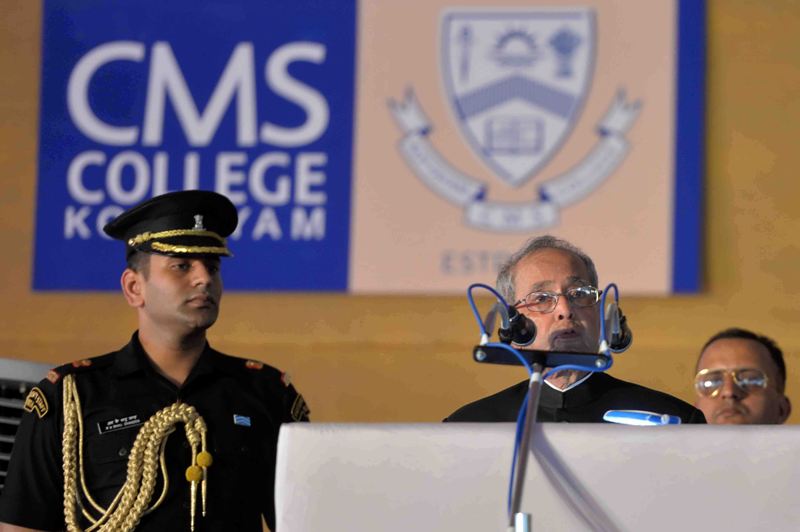
1.I am happy to visit Kottayam today to inaugurate the bicentenary celebrations of this historic CMS College and to lay the foundation stone of the bicentenary block. This college is a pioneer of modern education in Kerala. It is the second oldest college in the country after the Presidency College of Kolkata, to continuously impart higher education without a break. Starting with 40 students in its 1818 batch, it today has 2400 students, 150 teachers and 60 ministerial staff.
2.I understand my illustrious predecessor, President K.R Narayanan, was an alumnus of this College. Other eminent alumni include Chief Minister Oommen Chandy, scholar diplomats Sardar K.M. Panikar and KPS Menon, scientist Dr. E.C.G. Sudarshan; Justice K.T. Thomas, formerly of the Supreme Court of India; former chief editors of Malayala Manorama Mammen Mappilai, KM Cherian and KM Mathew; theatre personalities Prof. Omcherry N.N. Pillai and Kavalam Narayana Panicker etc.
Ladies and Gentlemen:
3.The Church Missionary Society after which this College is named, was a voluntary organization of clergy and laity belonging to the Church of England.In 1813, Colonel John Munroe, then Dewan of Travancore, appointed a commission to inquire into the socio-economic conditions of Syrian Christians in the province. He, thereafter, appealed to the British government in Madras to initiate the process for starting a college in Kottayam. The British Parliament acceded to Col Munroe’s request and opened a new chapter in history by empowering the East India Company to foray into missionary and educational work through an amendment of their Charter.
4.In conformity with the progressive traditions of the Travancore Royal family, Rani Lakshmi Bayi, then Regent Queen granted land, Rs. 500 in cash, and timber from public forests for the construction of buildings of this College on the banks of the Meenachil River. The construction was completed in 1815 and theological training of priests began the same year.
5.In 1817, ‘The College’, later known as ‘The College Cotym’ started functioning with Rev. Benjamin Bailey, as the first Principal. Rev Bailey laid the foundations of modern secular education by implementing a curriculum with subjects such as Syriac, Sanskrit, Latin, English, Greek, History, Mathematics, and Geography.
Friends:
6.The early students studied Virgil’sAeneid, Cicero’sOrations, Horace’sEpistles, and Euclid’sGeometry(all five volumes) using local material such as dried palm leaves and iron stencils instead of paper, pens, and quills. The academic programme at The College matched the University of Cambridge in rigour.
7.Students traveled several days by bullock carts from distant places to attend college accompanied by their elder relatives and with provisions to cook food on the way. Kottayam, which was a small village with a population of only about 320, ensconced in pristine green surroundings, soon became a magnet that attracted knowledge seekers from far and wide.
8.Recognizing that widespread dissemination of knowledge alone could lift people from ignorance, illness, and poverty, Rev. Bailey set up Kerala’s first printing press at The College in 1820. He designed the modern Malayalam script and adapted it for his printing machine. During a visit to The College, Maharaja Swathi Thirunal of Travancore was so impressed by Rev. Bailey’s work that he invited him to Thiruvananthapuram and entrusted him with the task of setting up the first printing press in the capital city.
9.Rev. Richard Collins, another former Principal of The College, established the Department of Malayalam with a view to streamlining the teaching and learning of the language. Exploiting the printing facility already available, the Department published the first-ever College Magazine in South India, titled,The Cotym College Quarterly,in 1864, which continues to be published even today under the nameVidya Sangrah.
Friends:
10.This College always welcomed students from different Christian denominations, as well as different religions and ethnic affiliations. The College produced students who questioned the continued presence of the British in India. Slogans demanding independence for India reverberated through the campus during our struggle for freedom.
11.CMS College has been the source of strong currents of knowledge and critical inquiry that have moulded the scholastic and socio-cultural landscape of Kerala as well as propelled the State to the forefront of social development. Over the years, it has attracted distinguished faculty, with unswerving commitment to their profession. Its students have at the same time distinguished themselves in various fields, achieving distinction in academics as well as cultural and sports activities.
Ladies and Gentlemen,
12.The history and achievements of the CMS College are a matter of legitimate pride for not only its students, faculty and administrators but also the entire State of Kerala.There is however little room for complacency. Higher education is the key to making available a large pool of skilled manpower essential for our economic development.
13.Our education system has to be geared up in terms of both quantity and quality. The demands of higher education in our country can be met only if private sector participates equally with the public sector institutions. The private sector has played a key role in higher education in many countries. Top international universities including Harvard, Yale and Stanford are the result of private sector efforts.
14. Kerala has been a pioneer and a path-breaker in many fields. Universal literacy and total primary education has been achieved.Its success in the field of literacy and school education has, however, not been matched by its achievements in higher education.The time has now come for the State to show its mettle by becoming a world leader in this field.
15.Some concerted efforts by our institutions in the recent past have shown good results. Indian institutions – not one but two - have found place for the first time amongst the top 200 universities in the world in rankings by a reputed agency. Two other Indian institutions have been ranked within the top 20 small universities in the world by another international agency.
16.If India has to be one of the front ranking nations in the world, the way ahead is only through a robust education system.
